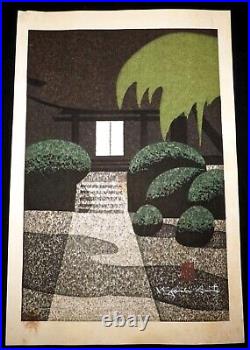
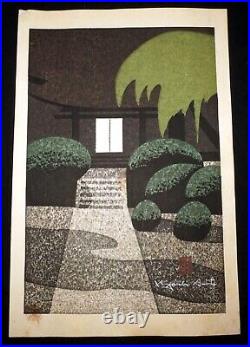
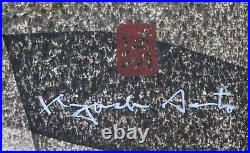
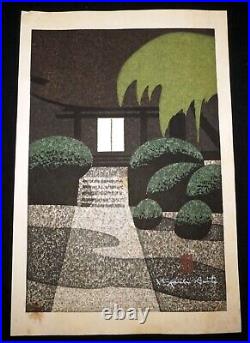
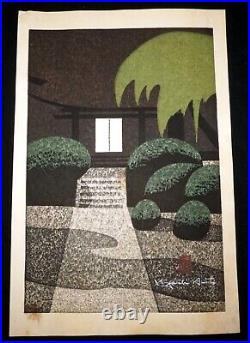
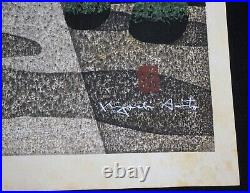
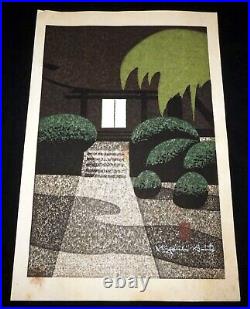
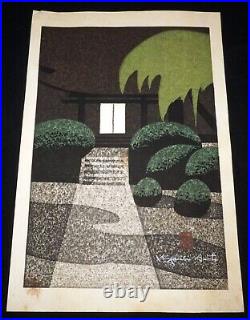
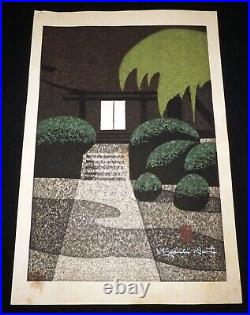
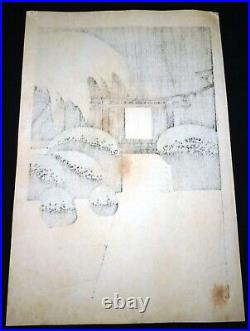

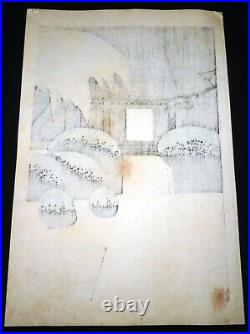
I appreciate your courtesy! The condition is described above for more information please check the photos. Print 15 inches x 10 inches. Sheet 17 ¼ inches x 11 ½. More about the artist. Japanese artist Kiyoshi Saito did not have it easy. Nature endowed him with an impulse for art and the drive to make the impossible possible. Saito studied European artists to recognize the qualities in the Japanese tradition itself, for which the modern international trends strive. His woodblock prints using traditional Japanese technique are among the most sought after pieces in the art market. Kiyoshi Saito was born in 1907 in a small village named Bange in the Kawanuma District of the Fukushima prefecture in the northern part of Honshu, the main Japanese island. When he was five years old, his father lost his business in Fukushima and the family moved further north to the island of Hokkaido, where his father worked in the coal mines in Otaru. When Kiyoshi Saito was thirteen years old, his mother died and he himself was sent away to become the guardian of a buddhist temple. He tried to escape but failed. Nevertheless the priests allowed him to return home. Saito then went to Hokkaido, where he took on a sign painting apprenticeship, which could have provided him a living for several years. At that time he dreamed of becoming a painter and he began to sketch gypsum casts at night. He founded his first sign painting business before his twentieth birthday and ensured himself a living and modest financial success. He reluctantly abandoned it, however, to study art in Tokyo. For the time being he was content with studying illustrations in western newspapers and collecting animations. While visiting Tokyo in 1932, he boldly decided to surrender himself to the big city life. He first worked as a sign painter and then later from 1944 until 1954 as an employee of the Asahi Newspaper Company. The job however was a secondary matter. More importantly, Saito became a close contact to Shiko Munakata through the job. Saito continued to paint with oil and taught himself the techniques of woodblock printing. In 1937 he presented both types of work for the first time in the famous Kokugakai Exhibition and was highly motivated. When he met Ono Tadashige at the Ginza Exhibition in 1939, he became a member of his artists group, which preceded the outside group Sosaku Hanga. There he discovered the possibilities of color woodcuts with multiple printing plates and his distinctive personal style began to take form. The acquaintance with mentor Koshiro Onchi soon opened doors to famous galleries, where most notably American purchasers took an interest in Saito’s work. Kiyoshi Saito emerged as Japan’s most productive woodblock print artist, whose editions soon found worldwide markets. Sosaku Hanga artists were, however, first dismissed in the Japanese art world and their works were considered concessions to American tastes. This abruptly changed, however, in 1951 at the first Sao Paulo Art Biennial, when a panel of judges gave prizes not to distinguished artists for oil paintings and sculptures but rather to two Hanga artists: for the etchings of Tetsuro Komai as well as to Kiyoshi Saito for a wood block print. The Japanese art world was shocked. Saito was also often sought after as an illustrator for newspapers or as a commercial graphic designer. The works of Kiyoshi Saito were influenced by the cultural legacies of northern Japan and also sometimes by its scarce landscape. A certain folksy-archaic roughness and a simultaneous expressionist abstraction give them a distinctive sense of contemporary printing. Saito also stayed true to the traditional Japanese techniques. He connected them, however, to modern two dimensional geometric principles. Saito’s work captures people with its compositional clarity and artistic simplicity. The bold abstraction and spontaneous design give his work a special quality. And it makes an extremely fresh and lively impression on those who are accustomed to showing a stamp/seal and a signature with the images – usually small tabloids. Motifs include everything from landscapes, portraits, and still life to animals and plants of all sorts. More pictures are available!!! It is important to know when purchasing items that. Please keep this in mind. As your ratings have immediate discount or listing-standing consequences for me. Thank you for understanding!! Charge you my costs. For all packing materials used. And everything has to be. To give you an idea, a. If it is not a free one from the Post Office, costs between. And I usually use at least 3 or 4 feet or more for breakable items. Per box (book box size) will be between. This item is in the category “Antiques\Asian Antiques\Japan\Prints”. The seller is “andresharnischbrokerageinc” and is located in this country: US.
- Featured Refinements: Japanese Woodblock Print
- Region of Origin: Japan
- Age: Post-1940
- Primary Material: Paper
- Maker: Kiyoshi Saito (Japan, 1907-1997)
- Original/Reproduction: Vintage Original
- Color: Multi-Color
No comments